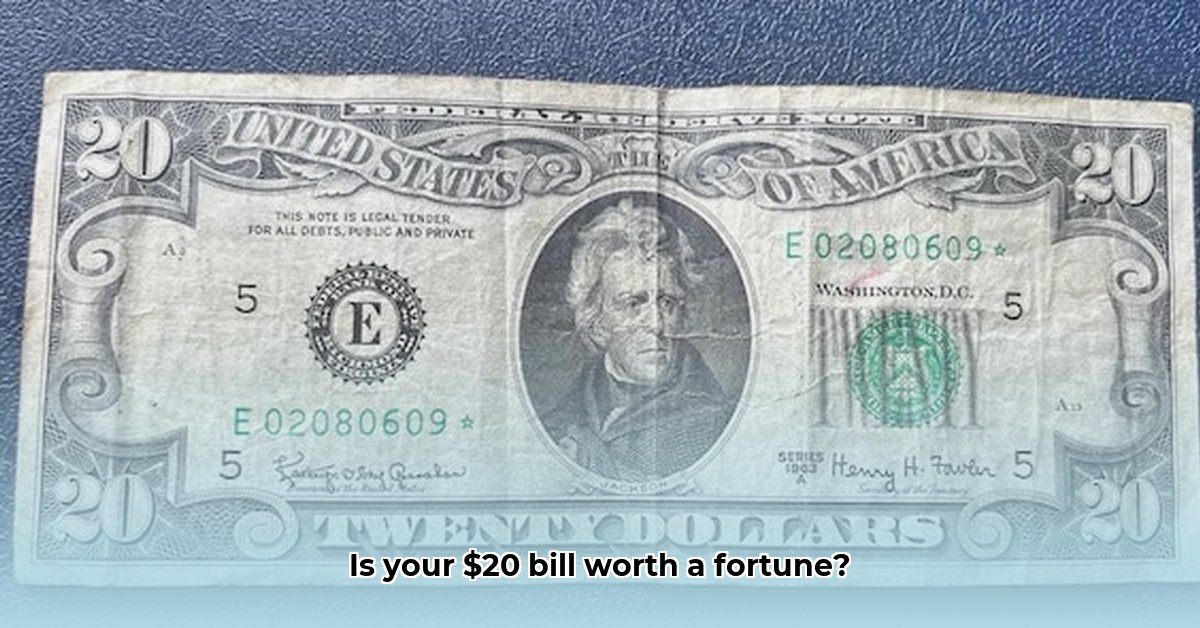
Found a 1963 twenty-dollar bill? Unlocking its potential value requires understanding its condition, rarity, and unique features. This guide provides a step-by-step approach to determine your bill's worth, empowering you to confidently assess its market value.
Understanding the Value of a 1963 $20 Bill
The value of your 1963 $20 bill isn't simply its face value. Several factors significantly impact its worth, transforming a seemingly ordinary piece of currency into a potential collector's item. These key elements—condition, series, star notes, Federal Reserve Bank designation, and serial number—intertwine to determine its market value.
1963 vs. 1963A Series: A Subtle Difference, Significant Impact
First, identify whether your bill is a 1963 or a 1963A series. This seemingly minor detail can significantly influence its value. Slight variations in printing and distribution between the two series create distinct collector interests and market values.
Condition: The Cornerstone of Value
The condition of your bill is paramount. A pristine, uncirculated bill will command a far higher price than a worn and damaged one. Numismatists (experts in coins and paper money) employ a grading system, typically ranging from "Poor" to "Gem Uncirculated," to assess condition.
Here's a simplified condition scale:
- Poor: Significant damage (tears, stains, heavy creasing).
- Fair: Heavy wear and tear, but still identifiable.
- Good: Noticeable wear, but generally legible.
- Very Fine: Minor wear, mostly crisp and clean.
- Extremely Fine: Minimal wear, appearing almost new.
- About Uncirculated: Very little to no signs of circulation.
- Gem Uncirculated (MS63 or better): Flawless condition, highly sought after.
Isn't it fascinating how a bill's condition can drastically alter its value? This highlights the importance of careful examination.
Star Notes: A Significant Value Booster
The presence of a star (*) near the serial number indicates a "star note," a rarity caused by a printing error. Star notes are highly coveted by collectors, substantially increasing a bill's value. Have you found a star note? This significantly increases collector interest.
Federal Reserve Bank: Location Matters
The Federal Reserve Bank (FRB) identifier on your bill also influences its worth. Some FRBs issued fewer notes than others, making these notes scarcer and more valuable. The location of the issuing FRB impacts scarcity and market value.
Fancy Serial Numbers: The Collector's Jackpot
Certain serial number patterns (repeating digits, low numbers, etc.), deemed "fancy" by collectors, can dramatically increase the value of your 1963 $20 bill. These unique serial numbers can transform an ordinary bill into a valuable collectible. Do you have a fancy serial number? This could be a game-changer.
How to Grade Your 1963 $20 Bill: A Step-by-Step Guide
Accurately grading your bill is crucial for determining its true value. This involves a careful examination using a system similar to the Sheldon scale (1-70), with higher numbers indicating better condition.
Steps to Grading:
Visual Inspection: Carefully examine the bill for wrinkles, tears, stains, creases, and pinholes. Assess the sharpness of the print and the color vibrancy. Note the centering of the design elements.
Key Features: Look for star notes and analyze the serial number for any unusual or aesthetically pleasing patterns.
Series Identification: Verify if it's a 1963 or 1963A series.
Professional Grading (Optional): For the most accurate assessment, consider a professional grading service like PCGS or NGC. This adds value and establishes authenticity.
Estimating the Value: Combining Factors
Once you've assessed condition, series, star note status, FRB, and serial number, you can consult online resources such as SerialWorth.com for estimated values. Remember that these are averages; individual bill values vary widely.
Here's a general value estimate based on condition (these values are approximate and can vary):
| Condition | Approximate Value (USD) |
|---|---|
| Poor | $5 - $10 |
| Fair | $10 - $20 |
| Good | $20 - $40 |
| Very Fine | $40 - $70 |
| Extremely Fine | $70 - $120 |
| About Uncirculated | $120 - $200 |
| Gem Uncirculated | $200+ |
Disclaimer: This guide provides general information. Consult a professional numismatist for an accurate appraisal. The true value of your 1963 $20 bill depends on the interaction of all the factors discussed here.